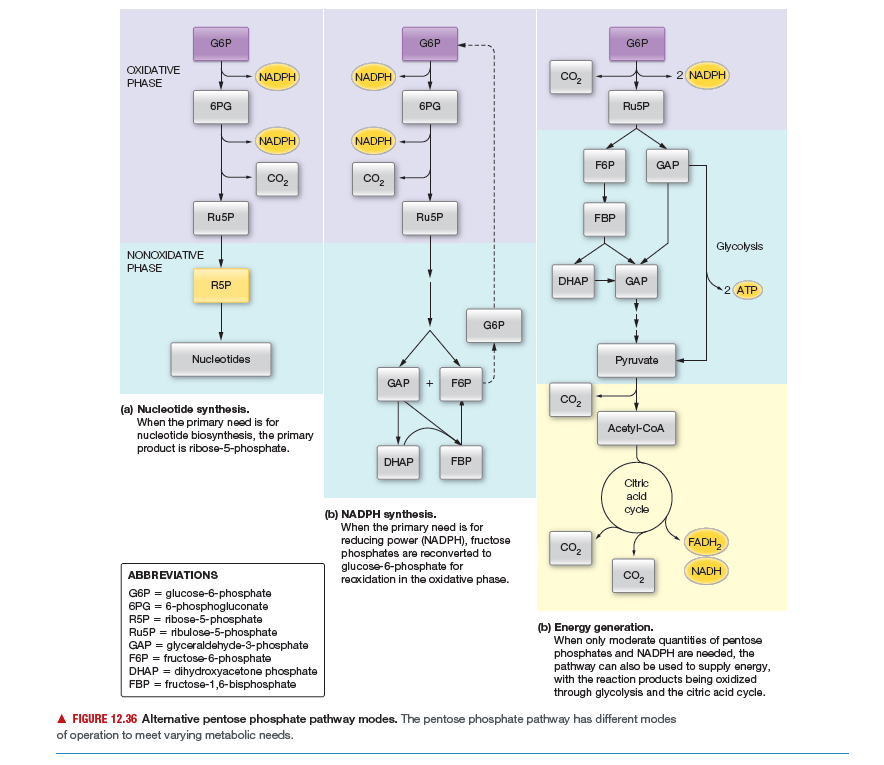G6P G6P G6P OXIDATIVE NADPH NADPH co2 2 NADPH PHASE 6PG 6PG Ru5P NADPH NADPH F6P GAP co2 cO2 Ru5P Ru5P FBP Glycolysls NONOXIDATIVE PHASE DHAP GAP R5P 2 ATP G6P Nucleotides Pyruvate GAP + F6P co, (a) Nucleotide synthesis. When the primary need is for nucleotide biosynthesis, the primary product is ribose-5-phosphate. Acetyl-CoA DHAP FBP Citric acld cycle (b) NADPH synthesis. When the primary need is for reducing power (NADPH), fructose phosphates are reconverted to glucose-6-phosphate for reaxidation in the oxidative phase. co2 FADH, NADH ABBREVIATIONS co2 G6P = glucose-6-phosphate 6PG = 6-phosphogluconate R5P = ribose-5-phosphate Ru5P = ribulose-5-phosphate GAP = glyceraldehyde-3-phosphate F6P = fructose-6-phosphate DHAP = dihydroxyacetone phosphate FBP = fructose-1,6-bisphosphate (b) Energy generation. When only moderate quantities of pentose phosphates and NADPH are needed, the pathway can also be used to supply energy, with the reaction products being oxidized through glycolysis and the citric acid cycle. A FIGURE 12.36 Altemative pentose phosphate pathway modes. The pentose phosphate pathway has different modes of operation to meet varying metabolic needs.
Electron Transport Chain
The electron transport chain, also known as the electron transport system, is a group of proteins that transfer electrons through a membrane within mitochondria to create a gradient of protons that drives adenosine triphosphate (ATP)synthesis. The cell uses ATP as an energy source for metabolic processes and cellular functions. ETC involves series of reactions that convert redox energy from NADH (nicotinamide adenine dinucleotide (NAD) + hydrogen (H)) and FADH2(flavin adenine dinucleotide (FAD)) oxidation into proton-motive force(PMF), which is then used to synthesize ATP through conformational changes in the ATP synthase complex, a process known as oxidative phosphorylation.
Metabolism
Picture a campfire. It keeps the body warm on a cold night and provides light. To ensure that the fire keeps burning, fuel needs to be added(pieces of wood in this case). When a small piece is added, the fire burns bright for a bit and then dies down unless more wood is added. But, if too many pieces are placed at a time, the fire escalates and burns for a longer time, without actually burning away all the pieces that have been added. Many of them, especially the larger chunks or damp pieces, remain unburnt.
Cellular Respiration
Cellular respiration is the cellular process involved in the generation of adenosine triphosphate (ATP) molecules from the organic nutritional source obtained from the diet. It is a universal process observed in all types of life forms. The glucose (chemical formula C6H12O6) molecules are the preferred raw material for cell respiration as it possesses a simple structure and is highly efficient in nature.
Write a balanced chemical equation for the pentose phosphate pathway in the first two modes depicted as shown, where (a) ribose-5-phosphate synthesis is maximized and (b) NADPH production is maximized, by conversion of the sugar phosphate products to glucose-6-phosphate for repeated operations of the pathway.

Trending now
This is a popular solution!
Step by step
Solved in 4 steps with 2 images


